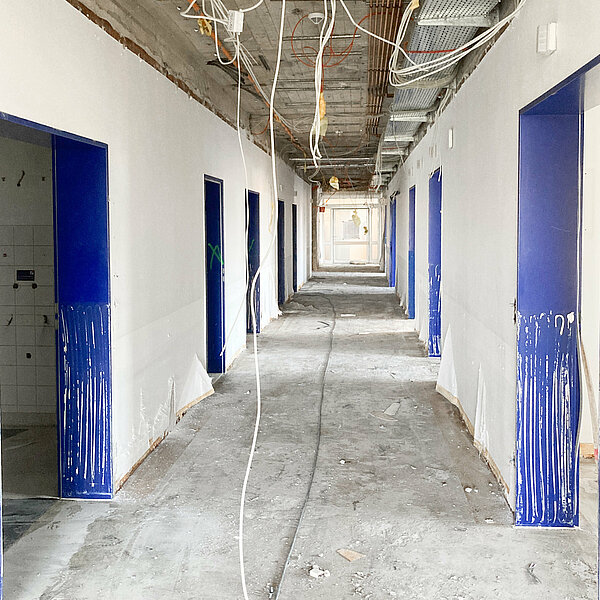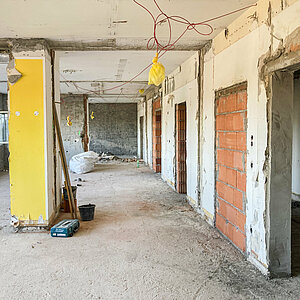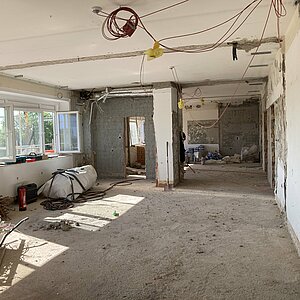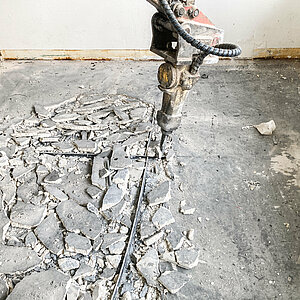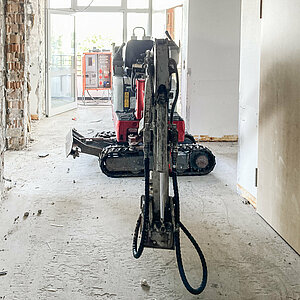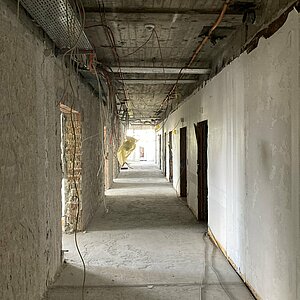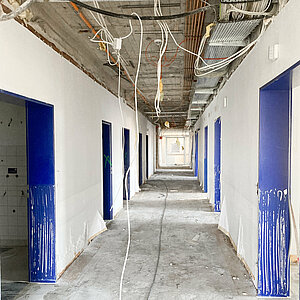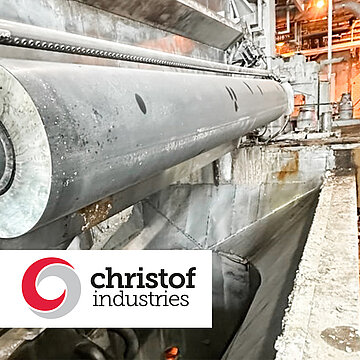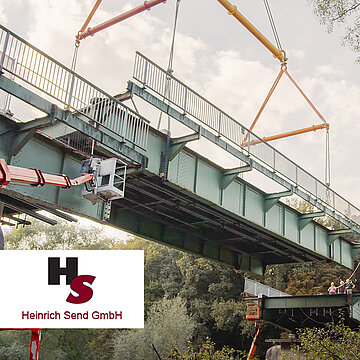
Conversion of the maternity ward at the Ev. hospital in Lippstadt
The Knepper Group demonstrated the utmost sensitivity and professionalism when dismantling the maternity ward at the Evangelical Hospital in Lippstadt.
Work carried out
- Highly sensitive gutting during ongoing hospital operations
- Dismantling of suspended ceilings
- Dismantling cladding
- Dismantling of building services
Machines in use
- Electric excavator with concrete shears and hydraulic hammer
- Manual chisel
- Construction crane with 45 meter radius
This project, which began in 2022, placed particularly high demands on Knepper's demolition specialists in addition to coronavirus: the high hygiene requirements of a hospital and the most discreet implementation possible so as not to disturb the patients. Knepper had already converted a number of wards at the Ev. Krankenhaus Lippstadt hospital in the past, but like all other companies, it had to compete in the public tender despite its many years of cooperation.
Ulrich Romweber, technical manager and project manager of the conversion project at Lippstadt Protestant Hospital, had been planning the dismantling of the maternity ward on the 3rd floor since 2017. "A project like this needs good planning. The conversion of the maternity ward required the ward to be temporarily relocated elsewhere. Not as a temporary solution, but in such a way that the parents-to-be feel comfortable and the best care for mothers and babies can be ensured," he explains.
To this end, a new building was erected at a cost of 3 million euros, which will house the maternity ward for the duration of the conversion and will then be used by other specialist departments. The reason for the conversion of the maternity ward was that, in addition to the four new delivery rooms, a sectional operating room for caesarean sections is to be available on the same level. The aim is to further improve the quality of care for expectant mothers, as the decision to have a caesarean section is often made at very short notice. Until then, Ulrich Romweber first had to find the right partner for the dismantling of the maternity ward on the 3rd floor.
The demolition work was put out to public tender and Knepper was able to score points in the selection process thanks to its proximity and experience. In the event of unforeseen situations, the company can react quickly.
"We are highly satisfied with Knepper's work.
Especially the way they responded to the special needs of a hospital"
Ulrich Romberger
Technical manager and project manager of the conversion project at Lippstadt Protestant Hospital
Dismantling and demolition mean noise, dust, emissions and vibrations. All factors that are difficult to reconcile with a highly sensitive area such as a hospital full of patients. The strict hygiene regulations made it impossible to use paths in the building. The only option: disposal via scaffolding on the two long sides of the building and a scaffolding tower with a platform and stairs, as well as with the help of a construction crane. First of all, the space for the construction crane with a reach of 45 meters had to be set up inside the depot. Even positioning the crane was a challenge due to the cramped situation. Access routes and the fire department access road had to be kept clear and the helicopter's approach area and the landing site could not be obstructed. In addition, there must always be space for the crane's docking area. In the next construction phase, a scaffolding stair tower was erected in each of the two inner courtyards, which ended with a platform at the top. The individual parts for the scaffolders were lifted in by crane. All routes for the Knepper team of six specialists led along the outside of the building via a separate entrance to the floor.
The other side of the floor, which was still in hospital operation, was additionally shielded by dust protection walls. This was followed by the time-consuming gutting and demolition of floor coverings, suspended ceilings, built-in cupboards, wall cladding and doors back to the shell. All materials had to be taken outside onto the platform by hand, from where they were transported down by crane and crane tipping bucket. Each waste fraction was disposed of separately in its own container. As only two containers could be placed next to each other due to lack of space, the collection and separation had to be very well planned. First wood, then ceilings, plasterboard and other materials were disposed of one after the other. Knepper also took on the removal of masonry walls, bricked up existing door openings and created new ones. For the plumbing and ventilation trades, openings and ducts were created for the installation of new pipes. Everything was thus perfectly prepared for the subsequent conversion.
Despite the tight schedule and a lot of manual work, the midday rest period in the hospital was observed and only work that did not cause any noise was carried out during this time. The chiseling work was carried out in the morning and afternoon. This minimized the disruption to patients and staff.
Knepper had estimated a total of 5 months for the project and started the preparatory work on May 12, 2022. The work was completed on August 29, 2022. The crane will remain in use for the following trades. If there are still tasks for the Knepper team, these can be completed quickly. "We are extremely satisfied with Knepper's work. Especially the way they responded to the special needs of a hospital," concludes Ulrich Romberger.
Your contact person
SALES DEMOLITION AND DISMANTLING
Phone: +49 2941 2841-310
E-Mail: vertrieb@knepper-gruppe.de
Further references
